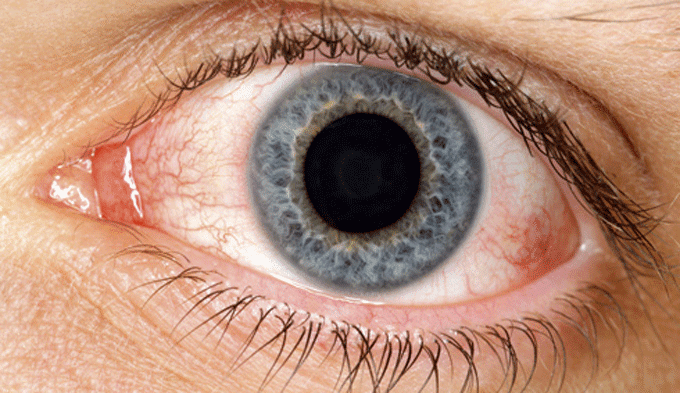What is dry eye syndrome?
Dry eye syndrome is a condition that affects the surface of the cornea and the conjunctiva due to a shortage of lacrimal fluid or because it is of poor quality. As a result, the surface of the eye is not well lubricated, which can lead to eye discomfort, vision problems and injuries to the cornea and conjunctiva.
What causes it?
Dry eye occurs when the lacrimal gland does not secrete enough lacrimal fluid to keep the eye lubricated.
The most common causes are:
- Decreased secretion due to age. Aging causes atrophy in the cells that are always producing lacrimal fluid
- Hormonal changes in women (pregnancy, oral contraceptive use and menopause)
- Environmental factors that produce significant evaporation (wind, air conditioners, heaters, etc)
- Prolonged reading, which reduces blinking and results in the inadequate distribution of lacrimal fluid and its increased evaporation
- Some systemic diseases (Sjögren’s syndrome, rheumatoid arthritis, lupus erythematosus, etc)
- The use of contact lenses
- Some ophthalmic surgery procedures
- Some diseases that scar the surface of the eye (such as severe viral conjunctivitis)
How can it be prevented?
Due to the serious consequences of dry eye (keratitis, scarring, loss of vision, corneal ulcers), regular specific ophthalmic check-ups are recommended.
Detection and early treatment are essential for the improvement and prevention of eye damage. Most at risk are the elderly and women in phases of hormonal change.
Some useful measures exist to prevent dryness of the eyes caused by environmental factors:
- Avoid exposure to air currents that can cause evaporation of lacrimal fluid (electric fans directed at the face or driving with the windows open, and always wear protective sunglasses when outside, etc.)
- Avoid dry atmospheres by using humidifiers
- Protect yourself from environmental pollution and avoid certain places like beaches and the countryside on windy days, as well as household dust, tobacco smoke and solvents
- Force yourself to blink several times a day and wipe your tear glands often with a towel or makeup removal sponge
Symptoms
Dry eye syndrome causes irritation, itching, redness and the sensation of a foreign body or grit on the surface of the eye, as well as fatigue, heavy eyelids and watery eyes.
Although it may seem contradictory, excessive watering of the eyes is due to inadequate and insufficient lubrication. Our body protects itself by ‘flooding’ the eye surface with poor quality tears that do not provide the necessary nutrients and protective factors.
Associated treatments
When it is not possible to directly treat the cause of dry eye, artificial tears and lubricating ointments can help to control dryness and irritation.
If these treatments do not alleviate symptoms, there is the option of conserving the patient’s lacrimal fluid by blocking the tear ducts and inserting a very small plug to prevent the rapid drainage of tears, thus helping to conserve moisture and protect the eye. Patients with more severe dry eye may require additional treatments.
Specialists who treat this pathology
FAQs
When the quality or the quantity of tears is not good –within a certain range– the body reacts and stimulates the secretion of tears as a protective measure. A circle is started: the eye perceives that it is dry and produces a little tear secretion, although because this is still not enough and does not solve the problem, it perceives it is dry again and produces a little more. This continues until the capacity of the tear drainage system is exceeded, leading to watery eyes.
Therefore, the use of artificial tears in patients with dry eye mostly solves the watery eye problem, as the eye is correctly lubricated and the balance is re-established.
In situations where dry eye symptoms occur, such as contact with chlorine in swimming pools, exposure to the sun or wind, air conditioning and eye strain (reading, driving, etc.), eye drop use should be increased. If symptoms persist, however, patients should see an ophthalmologist to assess the possibility of using other treatments.
It is the result of tear secretion and eyelid disorders that can cause redness, itching, burning, the sensation of a foreign body in the eye and eyestrain. Proper lubrication of the eye is achieved with a correct balance of good-quality tear production and the normal functioning of the eyelids. When this balance is broken or altered by external factors, tear production decreases, and there is a propensity for dry eye to develop.
Normal cellular aging in humans leads to reduced tear production. In fact, it is estimated that between the ages of 10 and 40, tear production is reduced by 50%. In addition, other common causes of dry eye are eye infections (conjunctivitis, corneal ulcers, etc.), external or environmental factors (sun, wind, chlorine, contact lenses, etc.) and certain medication. Cosmetics and cleansing creams can also cause irritation and disrupt tear production.
The eyelid muscles allow us to blink about 20,000 times a day.
IMO Institute of Ocular Microsurgery
Josep María Lladó, 3
08035 Barcelona
Phone: (+34) 934 000 700
E-mail: international@imo.es
See map on Google Maps
By car
GPS navigator coordinates:
41º 24’ 38” N – 02º 07’ 29” E
Exit 7 of the Ronda de Dalt (mountain side). The clinic has a car park with more than 200 parking spaces.
By bus
Autobus H2: Rotonda de Bellesguard, parada 1540
Autobus 196: Josep Maria Lladó-Bellesguard, parada 3191
Autobuses H2, 123, 196: Ronda de Dalt – Bellesguard, parada 0071
How to arrive at IMO from:
IMO Madrid
C/ Valle de Pinares Llanos, 3
28035 Madrid
Phone: (+34) 910 783 783
See map in Google Maps
Public transport
Metro Lacoma (líne 7)
Autobuses:
- Lines 49 & 64, stop “Senda del Infante”
- Line N21, stop “Metro Lacoma”
Timetables
Patient care:
Monday to Friday, 8 a.m. to 9 p.m.
IMO Andorra
Av. de les Nacions Unides, 17
AD700 Escaldes-Engordany, Andorra
Phone: (+376) 688 55 44
See map in Google Maps
IMO Manresa
C/ Carrasco i Formiguera, 33 (Baixos)
08242 – Manresa
Tel: (+34) 938 749 160
See map in Google Maps
Public transport
FGC. Line R5 & R50 direction Manresa. Station/Stop: Baixador de Manresa
Timetables
Monday to Friday, 09:00 A.M – 07:00 PM











